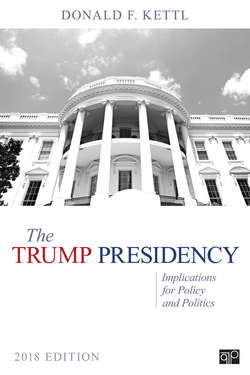Читать книгу The Trump Presidency - Donald F. Kettl - Страница 9
На сайте Литреса книга снята с продажи.
The Resistance and the Tweets
ОглавлениеThe Trump administration saw political motives in the legal attacks. In fact, the legal network that fought the executive orders was part of what had come to be called “the resistance,” and Democrats worked quietly behind the scenes to strengthen the power of state governments to fight back against Trump policies with which they disagreed. If Republicans dominated Congress, they believed they could slow down or stop the programs they disagreed with most in state governments and in the federal courts. In the case of the travel ban, the strategy worked.
The Trump administration prepared an appeal to the U.S. Supreme Court, in the hope of overturning the lower courts’ decisions. The administration’s attorneys worked to shore up their argument that the order was justified by national security concerns, not by a focus on a particular religion.
The president’s own tweet storm on June 5, however, made that job far harder. Starting at 6:25 in the morning, he told his Twitter followers that anyone could call his executive orders whatever they wanted, but he was calling it “what it is, a TRAVEL BAN.” He even attacked his own Justice Department, where attorneys rewrote the original order to try to nudge it past judicial scrutiny and criticized the “politically correct” version they redrafted. He returned to his “extreme vetting” theme and, in case anyone missed the point, underlined the argument late in the day with a tweet saying “we need a TRAVEL BAN” (see Figure 4-1).
Figure 4 Trump Tweets on the Travel Ban
President Donald J. Trump/Twitter
Even some of Trump’s closest allies worried the tweets might undercut the administration’s legal case before the Supreme Court. George Conway, a seasoned Republican attorney and spouse of Kellyanne Conway, one of the president’s top advisors, said of Trump’s tweets: “These tweets may make some ppl feel better, but they certainly won’t help OSG get 5 votes in SCOTUS, which is what actually matters. Sad.”13 (OSG refers to the Office of the Solicitor General in the Justice Department, which prepares the government’s case for argument before the U.S. Supreme Court. SCOTUS is the Supreme Court of the United States.)
Government attorneys knew that lower federal courts had twice struck down the travel ban. They worried that the case was difficult to win because, regardless of how the executive orders were drafted, there was a long string of public comments during the campaign about extreme vetting and a Muslim ban, which Trump reinforced with his tweets. The president’s tweets undoubtedly warmed the fires in his political base. But the administration saw action on one of its foremost promises ebb away under relentless political and legal counterattacks.
In June, Trump eventually found a win on the travel ban issue. The Supreme Court heard an appeal of the lower-court decision and ruled that the administration could pursue a more-limited version of its travel ban. Individuals with a “bona fide relationship” with someone in the country could enter the country, but the administration could ban others, pending a review in the fall. But that led to a new battle over what a “bona fide relationship” was. Parents, spouses, and children, the administration argued, should receive permission—but not grandparents. In yet more court battles, the Trump administration lost its position on grandparents—they would be eligible to enter the country. But the twists and turns in the courts continued.
Meanwhile, Trump continued to insist he would build his wall and subject potential immigrants to extreme vetting. Following a terrorist attack on the London subway in September, he let loose a flurry of tweets, including one that argued yet again for a broader travel ban (see Figure 5-1). When his base worried that he was backing away from his commitment to building the wall, he followed with another tweet (Figure 5-2). But the rhetorical battles on Twitter often proved louder than the progress he was making on the policy front.
Figure 5 Trump Tweets on the Wall and the Travel Ban (September 15, 2017; September 14, 2017)
President Donald J. Trump/Twitter
Trump continued to insist throughout 2017 that he was going to build the wall. And, despite counsel from his attorneys, he continued to focus on what he viewed as threats from Muslims, including tweets of uncorroborated charges that drew a stiff rebuke in late November from British prime minister Theresa May. His travel ban remains tied up in the courts, and his wall remains unbuilt. But the policy battles often proved less important than the rhetorical ones. Trump continued to focus on the insecurity felt by many Americans. He promised that his wall and travel ban would make them feel more secure.
